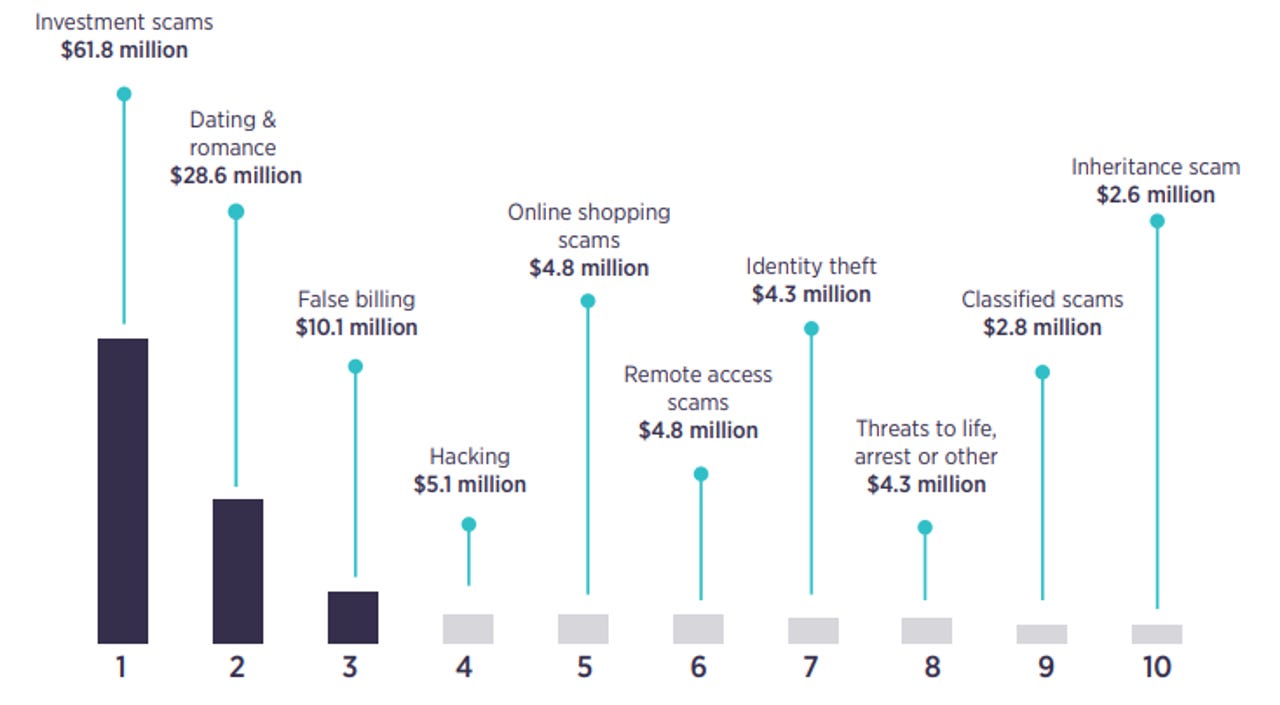Australians reported 25,000 phishing scams last year


Top scams by loss, as reported to Scamwatch
Australians reported 167,797 scams to the Australian Competition and Consumer Commission (ACCC)-controlled Scamwatch in 2019.
A 34% increase over the year prior, the financial impact in 2019 to Australians was just over AU$634 million. This was an average loss of AU$7,224. The Scamwatch Targeting scams 2019: A review of scam activity since 2009 report [PDF] showed only 11.8% of scam reports included a financial loss.
The greatest losses in 2019 by type of scam were: AU$132 million to business email compromise (BEC) scams, AU$126 million to investment scams, and AU$83 million lost to dating and romance scams.
See also: Cybersecurity warning: These scammers are looking for a way into your email accounts
In 2019, phishing was the most common method for scamming, with 25,168 reports. 513 of those reported resulted in a financial loss, valued at AU$1.5 million.
Identity theft came in third with 11,373 reports, and 562 of those resulted in a loss totalling just over AU$4.3 million. There were 9,019 remote access scams, with 682 of those costing Australians AU$4.8 million; and "hacking" as a scam type was reported 8,321 times, with 509 of those resulting in a loss of AU$5.1 million.
In 2019, reported losses for cryptocurrency scams exceeded AU$21.6 million from 1,810 reports.
"Cloud mining farms became a common adaptation of this type of scam. Most were Ponzi schemes, with no real cryptocurrency involved," the report explained.
Scamwatch said that an international Ponzi cryptocurrency scam -- USI Tech -- hit Australia last year. It received over 200 reports about USI Tech, with losses of AU$3.3 million, mostly via Bitcoin.
The top two payment methods for scams in 2019 were bank transfers at AU$70 million and Bitcoin at AU$19 million.
The highest overall loss was experienced by those aged 55-64, and the age bracket reporting the most scams were aged 65 and above, followed by those aged 25-34. 18-24-year-olds comprised only 4% of the total losses. People aged 55 to 64 lost nearly AU$30 million.
Men were most fooled by investment scams, and women by dating and romance scams.
Phone remains the main avenue for scamming, with 69,522 reports; followed by email with 40,277 reports; text message with 27,894 reports; and "the internet" was the scam method for 11,776 reports.
AU$32.6 million was lost via phone, and despite only being responsible for 7% of overall scams, "the internet" saw victims lose AU$31.6 million.
See also: Australian government introduces new telco regulations to fight phone scams
"Unfortunately financial losses to scams are grossly understated," ACCC chair Delia Rickard said.
"Scammers have moved to unexpected platforms to target victims. For example, in 2019 we saw dating and romance scammers targeting unsuspecting victims through gaming apps such as Words With Friends, and investment scammers targeting Facebook and Instagram users with 'get rich quick' cryptocurrency investment scams."
Losses to text message scams increased by 40% in 2019, at just under AU$97,000, despite there being only 9% more reports. The report showed many of these were phishing scams impersonating banks, myGov, Australia Post, and JB Hi-Fi.
Scams received through social media also increased in 2019: Social networking contacts increased by 20% and mobile app contacts increased by 29%.
In 2019, businesses reported 5,904 scams to Scamwatch, with losses of over AU$5.3 million. False billing scams caused the highest losses, at AU$2.7 million.
The most financially damaging BEC scams involved invoices between businesses, suppliers, or individuals being intercepted and amended with fraudulent banking details. The report showed businesses were mostly targeted by scammers impersonating senior managers, staff, and suppliers.
The ACCC published the first Targeting scams report in 2009 and has released 11 to-date.
Looking back, the report showed Australians have reported losing AU$2.5 billion to scams between 2009 and 2019. In 2009, losses totalling AU$69.9 million were reported to Scamwatch.
Unsurprisingly, advances in technology over the past decade have contributed to the proliferation of scams affecting Australians.
"While most scams remain fundamentally the same as in 2009, many have adapted over time to use social media, new payment methods, and online services to source new victims or legitimise their stories," the report adds.
"New scams have also emerged, such as business email compromise and cryptocurrency investment scams. These are now some of the most financially damaging scams for Australians."
ReportCyber replaced ACORN as the Australian Government's online cybercrime reporting portal in July 2019.
The ACCC's latest report comprised data from the Big Four banks -- ANZ Bank, the Commonwealth Bank of Australia, the National Australia Bank, and Westpac -- for the first time.